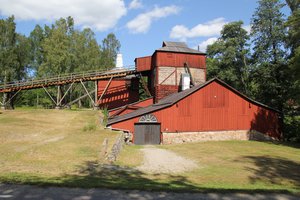Advertisement
Published: November 10th 2014

 The Smelting House
The Smelting House
It was in the Smelting House the blast furnace was housed and the blast furnace was the heart and soul of the ironworks.Engelsberg - one of Sweden's World Heritage Sites
Sweden's World Heritage sites includes marvelous architecture, such as the Hanseatic Town of Visby and Drottningholm Palace, wonderful nature, such as the High Coast and Laponia, and historical sites, such as the Viking Town Birka and Tanum Rock Carvings. This blog entry however is about one of the lesser known and consequently also not much visited World Heritage sites in Sweden - Engelsberg Ironworks.
Mining has long been an important industry in Sweden and two of the Swedish World Heritage sites aim to preserve historical mining sites. One of those is the copper mine in Falun and the other is Engelsberg Ironworks.
The Swedish district Västmanland is today somewhat of a backwater. That has not always been the case though. Once the area was more prosperous than today when forests and mines were more important for the economy than they are today. The mining district is sometimes referred to as Bergslagen. Small scale mining likely started more than 2000 years ago. For well over a thousand years mining was a side business to farming and working in the forest. Iron was only produced a

 The manor house
The manor house
The manor house is privately owned and this is as close as you can get to itfew months each year when there was no work to be done in the fields or in the forest. In the 17
th century industial scale mining was started in several places.
One of the locations where iron ore was mined and iron was produced was Ängelsberg and the production facilities, Engelsberg Ironworks, are remarkably well preserved. The site has such high historical value that UNESCO in 1993 added Engelsberg Ironworks to the World Heritage List.
UNESCO’s description of Engelsberg Ironworks is as follows: “Sweden's production of superior grades of iron made it a leader in this field in the 17th and 18th centuries. This site is the best-preserved and most complete example of this type of Swedish ironworks.”
Iron was produced at Engelsberg Ironworks until the end of World War I. The owner realized the historical value of preserving the site as far as possible and turned the ironworks into a kind of museum. Today Engelsberg Ironworks is owned by the privately owned company Nordstjernan. Luckily they permit visitors to see most of the site. The only significant building of the site that is out of bounds is the manor house.

 Stone signpost
Stone signpost
EB stands for Engelsbergs Bruk which in English is Engelsberg IronworksOver 50 buildings are preserved and are part of the World Heritage. The most important, and in my opinion the most interesting, of those is the Smelting House. It was in the Smelting House the blast furnace was housed and the blast furnace was the heart and soul of the ironworks. The furnace still stands and is in such good condition that it probably could be lit up today and used for its original purpose.
The other buildings include
=> The manor house.
=> The smithy, where the raw iron from the blast furnace was refined to high quality iron bars
=> The firestation
=> The gardener's house
=> The washing house cum bakery. Isn't it odd to combine those two functions in the same house?
=> An office building
=> Private homes
=> Storage houses
Pretty much all of Engelsberg Ironworks is preserved and very little is added or changed and that is what makes the site special. A few buildings have been lost over the years, such as an orangerie and a water mill, but most is intact. So is also

 Possibly the foreman's home
Possibly the foreman's home
I never took any photo of the sign that tells the story of this house. An educated guess is that it was the home of the foremanmost of the paperwork from all the years of iron production. So scholars who wish to study iron production have a great source of information to dig from.
During the summer 2014 a large
wildfire raged forests in Västmanland. For a few days there was even a danger that the fire might reach Engelsberg Ironworks. Fortunately the fire stopped a few kilometers short of the site and the heritage site was spared. The forests around Engelsberg were not spared however. Between 140 and 150 squarekilometers was affected, that is roughly twice the size of Manhattan, and driving through there now is probably a very different experience from what it was like before the fire.
Although Engelsberg is not a spectacular place to visit I thought it was a good day trip from Stockholm. I am happy I decided to spend a day on going there.
Advertisement
Tot: 0.06s; Tpl: 0.011s; cc: 20; qc: 29; dbt: 0.0245s; 1; m:domysql w:travelblog (10.17.0.13); sld: 1;
; mem: 1.2mb

 The Smelting House
The Smelting House
 The manor house
The manor house
 Stone signpost
Stone signpost
 Possibly the foreman's home
Possibly the foreman's home



































Dancing Dave
David Hooper
Engelsberg
“Sweden's production of superior grades of iron made it a leader in this field in the 17th and 18th centuries. This site is the best-preserved and most complete example of this type of Swedish ironworks.” When its all gone Ake this little baby will live on. Fascinating blog on the pioneers of industry that carved so much of the history of Europe. Lest we forget.